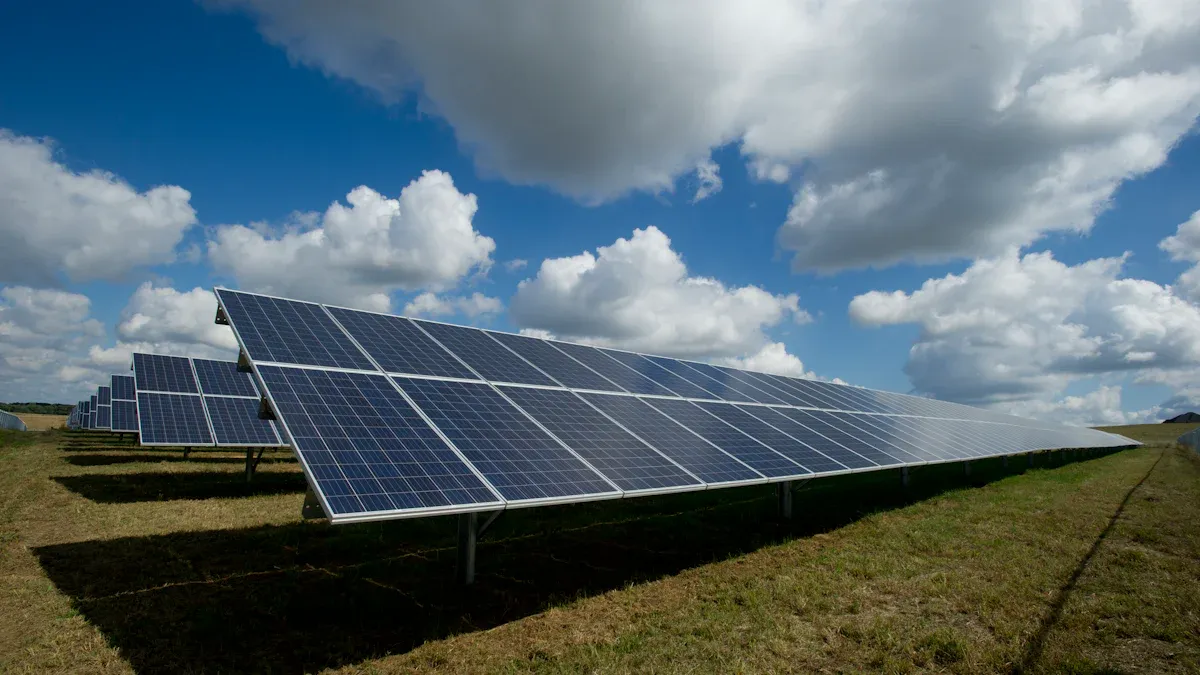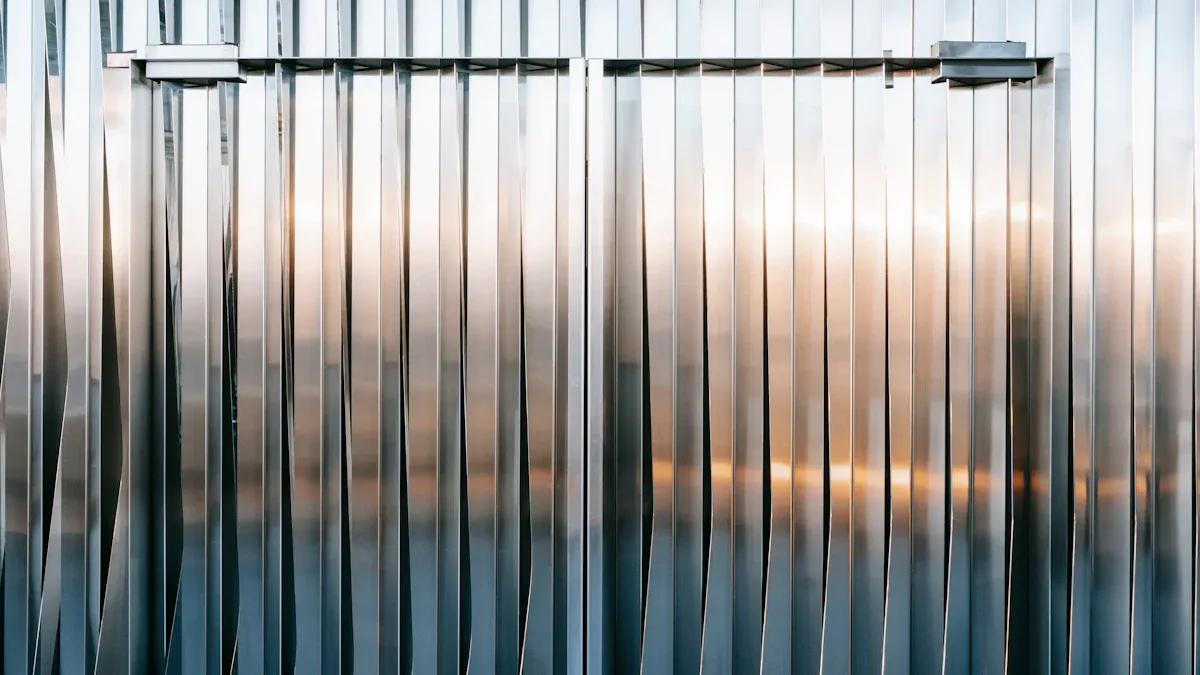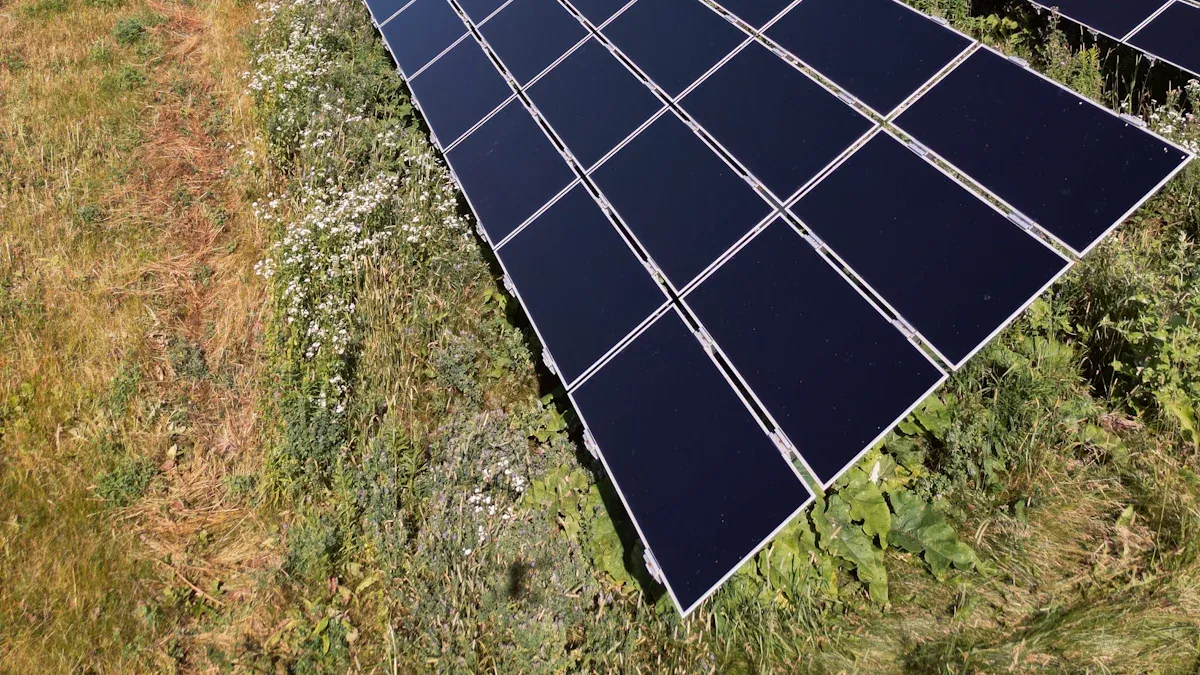The hidden cost differences over a 10-year lifecycle between low-cost and branded Steel Structure for PV Panel

Over a 10-year period, branded steel structures often prove more cost-effective for PV panel installations. Many decision-makers focus on the initial price, but hidden expenses quickly add up when using a low-cost Steel Structure for PV Panel. Maintenance, repairs, and system downtime frequently offset any upfront savings. A branded solution reduces these risks and delivers superior long-term value.
Key Takeaways
Branded steel structures cost more upfront but save money over 10 years by reducing repairs, maintenance, and downtime.
High-quality materials and coatings in branded structures prevent corrosion and keep PV panels properly aligned for better energy output.
Longer warranties from branded manufacturers protect owners from unexpected repair costs and financial risks.
Choosing branded steel structures lowers hidden costs like frequent repairs, insurance premiums, and disposal fees.
Evaluating total lifecycle value, not just initial price, ensures a durable, efficient, and profitable PV panel installation.
Cost Comparison

Upfront Price
Many project managers notice a significant difference in the initial cost between low-cost and branded steel structures. Low-cost options often attract buyers with a lower sticker price. For example, a basic Steel Structure for PV Panel may cost 20-30% less than a branded alternative. This price gap can seem appealing, especially for large-scale installations where every dollar counts.
Note: The upfront savings from low-cost structures can quickly disappear when considering the full project lifecycle.
Procurement teams often focus on immediate budget constraints. They may overlook the fact that cheaper materials and manufacturing shortcuts can lead to hidden expenses down the road. Branded steel structures typically use higher-grade materials and advanced coatings, which increase the initial investment but set the stage for long-term reliability.
Long-Term Value
Over a 10-year period, the true value of a steel structure becomes clear. Branded products deliver consistent performance and require fewer repairs. They resist corrosion, withstand harsh weather, and maintain structural integrity. These factors reduce the risk of unexpected failures and costly downtime.
A simple comparison table highlights the difference:
Factor | Low-Cost Structure | Branded Structure |
|---|---|---|
Lower | Higher | |
Maintenance Frequency | High | Low |
Downtime Risk | Elevated | Minimal |
10-Year Cost | Unpredictable | Predictable |
Facility owners who choose branded solutions often report lower total expenditures over time. They avoid frequent repairs, minimize labor costs, and protect their PV panel investment. The long-term value of a branded Steel Structure for PV Panel often outweighs the initial savings from a low-cost alternative.
Durability and Maintenance

Material Quality
Material quality plays a decisive role in the long-term performance of steel structures in PV panel systems. Branded products often use advanced alloys and nanotechnological coatings that form strong barriers against moisture, salt, and pollutants. These features help prevent corrosion and maintain the structural integrity of the Steel Structure for PV Panel. In contrast, low-cost alternatives frequently rely on inferior materials and lack robust protective coatings. This difference exposes them to faster deterioration, especially in harsh environments such as coastal or industrial areas.
Tip: Selecting materials like stainless steel or coated steel for high-exposure sites can significantly extend the lifespan of mounting structures.
Repair Frequency
Low-cost steel structures tend to require more frequent repairs due to their limited corrosion resistance and weaker design. Without adequate protection, these structures develop rust and structural weaknesses much sooner. Regular inspections often reveal early signs of damage, leading to increased repair interventions. Branded structures, designed with higher load-bearing capacity and modular components, withstand wind, snow, and salt exposure more effectively. This resilience reduces the need for repairs and helps maintain system reliability.
Low-cost options increase maintenance and repair needs, reducing project profitability.
Robust design and quality coatings minimize repair frequency and costs.
Maintenance Costs
Maintenance costs over a 10-year period can vary dramatically between low-cost and branded steel structures. The following table highlights key differences:
Feature | Steel PV Structures | Typical PV Modules |
|---|---|---|
Expected Lifespan | About 25 years | |
Corrosion Resistance | High | Moderate |
Maintenance Needs | Low | Moderate |
Branded steel structures with advanced coatings require less frequent maintenance, which lowers operational expenses. Protective coatings such as zinc-dust primers and phenolic layers can extend service life by at least 10%. Choosing certified and engineered solutions ensures durability, reduces maintenance needs, and supports long-term profitability for PV panel installations.
Performance Impact
PV Panel Output
The quality of mounting structures plays a crucial role in the long-term efficiency of photovoltaic systems. High-quality steel, such as galvanized or stainless steel, resists corrosion and maintains its strength over time. This durability ensures that PV panels remain properly aligned. Proper alignment is essential because even small shifts in tilt angle can cause significant energy losses. For example, a misalignment of just 31–33 degrees can reduce energy output by about 10%. Over a decade, these losses add up and can impact the overall return on investment.
Low-cost structures often use inferior materials that corrode or deform more quickly. Rust and structural instability can lead to panel misalignment. When panels lose their optimal angle, they capture less sunlight and generate less electricity. Regular inspections and maintenance help preserve output, but branded structures require less intervention due to their superior build quality. Professional installation and compliance with building codes also contribute to stable, efficient performance throughout the system’s lifespan.
Note: Consistent panel alignment over 10 years maximizes energy production and protects revenue streams.
Downtime Risks
Downtime poses a hidden threat to the profitability of PV installations. Structural failures, corrosion, or misalignment in low-cost steel systems can force operators to shut down sections of the array for repairs. Each hour of downtime means lost energy production and reduced income. Branded structures, engineered for durability, minimize these risks by maintaining their integrity under harsh conditions.
Operators with low-cost systems often face more frequent interruptions. These interruptions require emergency repairs and increase labor costs. In contrast, branded solutions provide peace of mind with fewer unexpected outages. Reliable structures support continuous operation, helping owners achieve predictable energy yields and stable financial performance.
Risk Factor | Low-Cost Structure | Branded Structure |
|---|---|---|
Downtime Frequency | High | Low |
Output Losses | Significant | Minimal |
Maintenance Needs | Frequent | Rare |
Warranty and Support
Coverage Differences
Warranty coverage creates a major distinction between low-cost and branded steel structures. Branded manufacturers usually offer comprehensive warranties that cover both materials and workmanship for 10 years or more. These warranties often include clear terms for corrosion, structural failure, and even paint or coating defects. In contrast, low-cost suppliers may provide only limited warranties, sometimes as short as one or two years. These warranties often exclude common issues like rust or deformation.
A quick comparison highlights the differences:
Feature | Low-Cost Structure | Branded Structure |
|---|---|---|
Warranty Length | 1–2 years | 10–25 years |
Coverage Scope | Limited | Comprehensive |
Claim Process | Complicated | Streamlined |
Note: A longer, more comprehensive warranty reduces the risk of unexpected expenses and supports long-term project stability.
Financial Risks
Warranty limitations can expose owners to significant financial risks. When a low-cost structure fails outside its short warranty period, the owner must pay for repairs or replacements. These unplanned costs can disrupt budgets and reduce project profitability. Branded structures, with their extended warranties, shift much of this risk to the manufacturer.
Key financial risks include:
Out-of-pocket repair costs after warranty expiration
Increased insurance premiums due to higher failure rates
Revenue loss from system downtime during repairs
Branded solutions help owners avoid these pitfalls. Reliable support and clear warranty terms protect investments and ensure predictable financial performance over the system’s lifecycle.
End-of-Life and Resale
Resale Value
Branded steel structures often retain higher resale value at the end of their service life. Buyers in the secondary market look for reliability, certification, and traceable manufacturing standards. Branded products usually come with documentation that proves their quality and performance history. This transparency increases buyer confidence and supports higher resale prices.
Low-cost structures rarely offer the same level of documentation or quality assurance. Potential buyers may hesitate to purchase used components with unknown origins or questionable durability. As a result, owners of low-cost systems often face limited resale opportunities and lower returns.
Tip: Owners who maintain detailed records of inspections and maintenance can further boost resale value.
A quick comparison highlights the difference:
Factor | Low-Cost Structure | Branded Structure |
|---|---|---|
Documentation | Rare | Comprehensive |
Buyer Demand | Low | High |
Typical Resale Price | Low | Moderate-High |
Disposal Costs
Disposal costs can impact the total lifecycle expense of a PV system. Branded steel structures often use recyclable materials and comply with environmental standards. Recycling companies accept these materials more readily, which can reduce disposal fees. Some branded manufacturers even offer take-back programs, further lowering end-of-life costs.
Low-cost structures may contain mixed metals or coatings that complicate recycling. Disposal companies may charge extra to handle hazardous coatings or non-standard alloys. Owners may also face regulatory penalties if they fail to dispose of materials properly.
Branded structures: Lower disposal fees, easier recycling, fewer regulatory risks.
Low-cost structures: Higher fees, complex recycling, potential compliance issues.
Note: Factoring in disposal costs during the initial purchase decision helps avoid unexpected expenses later.
Total Cost of Ownership
10-Year Breakdown
A comprehensive 10-year cost analysis reveals the true financial impact of choosing between low-cost and branded steel structures for PV panel installations. Many decision-makers focus on the initial purchase price, but the total cost of ownership includes much more than upfront expenses. Over a decade, factors such as maintenance, repairs, downtime, and system performance play a significant role in determining the real value of each option.
The following table presents a side-by-side comparison of estimated costs over a 10-year period:
Cost Category | Low-Cost Structure | Branded Structure |
|---|---|---|
Initial Purchase | $100,000 | $130,000 |
Scheduled Maintenance | $30,000 | $10,000 |
Unplanned Repairs | $25,000 | $5,000 |
Downtime Losses | $20,000 | $3,000 |
Efficiency Losses | $15,000 | $2,000 |
Insurance Premiums | $8,000 | $4,000 |
End-of-Life Disposal | $7,000 | $3,000 |
Total (10 Years) | $205,000 | $157,000 |
Note: These figures represent typical scenarios for a medium-sized commercial PV installation. Actual costs may vary based on site conditions and project scale.
Branded structures require a higher initial investment, but they deliver predictable costs and fewer surprises over time. Low-cost options often lead to escalating expenses that erode any upfront savings.
Hidden Costs
Many project budgets overlook hidden and indirect costs that can significantly affect the total cost of ownership. These expenses often remain invisible during the procurement phase but emerge throughout the project lifecycle. Common hidden costs associated with low-cost steel structures include:
Increased project management expenses due to frequent repairs and coordination
Higher site logistics costs, especially when temporary facilities or equipment are needed for unplanned maintenance
Additional permitting and regulatory compliance fees if repairs or replacements trigger new inspections
Elevated financing, insurance, and legal costs resulting from higher risk profiles
Project teams sometimes underestimate these indirect costs. For example, a wind farm project faced an unexpected $12 million in site logistics expenses because of underestimated hidden costs. Similar risks apply to PV projects using low-cost steel structures, as both require careful project management and regulatory compliance.
Downtime and efficiency losses also contribute to hidden costs. When a Steel Structure for PV Panel fails or requires frequent maintenance, operators must shut down parts of the system. Each hour of downtime reduces energy production and revenue. Misalignment or structural degradation can lower the system’s efficiency, increasing the levelized cost of energy (LCOE) over time. Branded structures help maintain optimal performance, keeping LCOE low and protecting long-term profitability.
Tip: Decision-makers should evaluate all direct and indirect costs—not just the purchase price—when selecting a steel structure for PV panel projects.
Choosing Steel Structure for PV Panel
Key Considerations
Selecting the right steel structure for PV panel installations requires careful evaluation of several critical factors. Project teams should focus on both technical and practical aspects to ensure long-term success.
Key considerations include:
Material selection: Teams should choose steel types and coatings that match environmental conditions. Galvanized or stainless steel resists corrosion and extends service life.
Site and soil analysis: Soil tests, such as bore tests and groundwater checks, help determine the best foundation type and prevent future structural issues.
Foundation type: The foundation must suit soil conditions and load requirements. Options include driven piles, helical piles, earth screws, or ballasted foundations.
Structural load considerations: Engineers must account for dead loads, live loads, wind, and seismic forces. Following standards like ASCE 7-10 and local codes ensures safety.
Design and engineering codes: Using certified materials and fasteners, along with licensed structural engineers for stamped drawings, guarantees compliance and reliability.
Procurement tips: Teams benefit from planning material needs, building supplier relationships, and inspecting materials for quality. Monitoring market prices helps balance cost and quality.
Installation methods: Proper mounting orientation, corrosion-resistant fasteners, and stable foundations help structures withstand environmental forces.
Inspection and maintenance: Regular inspections for corrosion, loose fasteners, and structural integrity, along with timely repairs, extend the lifespan of the installation.
Tip: Addressing these factors during planning and execution leads to a safer, more durable, and cost-effective PV system.
Lifecycle Value
Evaluating lifecycle value means looking beyond the initial purchase price. Branded solutions often deliver greater value over time because they reduce maintenance needs and minimize downtime. High-quality materials and engineering lower the risk of unexpected repairs.
A well-chosen Steel Structure for PV Panel maintains its integrity and performance for decades. Owners benefit from predictable costs, higher energy output, and better resale value.
Decision-makers who prioritize lifecycle value protect their investment and ensure the long-term success of their PV projects.
Branded steel structures deliver lower total lifecycle costs for PV panel installations. The 10-year analysis shows that higher upfront investment leads to fewer repairs, less downtime, and better resale value. Decision-makers should select a Steel Structure for PV Panel based on long-term value, not just initial price. Considering hidden and indirect costs protects project profitability and ensures reliable energy production.
FAQ
What are the main hidden costs of low-cost steel structures for PV panels?
Hidden costs include frequent repairs, higher maintenance, increased downtime, and lower resale value. These expenses often exceed the initial savings from choosing a low-cost structure.
How does a branded steel structure improve PV panel performance?
Branded steel structures maintain alignment and resist corrosion. This stability helps PV panels produce more energy over time. Owners see fewer interruptions and higher long-term output.
Do branded steel structures come with better warranties?
Yes. Branded options usually offer longer and more comprehensive warranties. These warranties cover materials, workmanship, and corrosion, reducing financial risk for owners.
Can low-cost steel structures affect insurance premiums?
Insurance companies may charge higher premiums for low-cost structures. Frequent failures and increased risk lead to higher costs for coverage.
Is it possible to recycle branded steel structures at the end of their life?
Most branded steel structures use recyclable materials. Owners can often recover value through recycling programs, which lowers disposal costs and supports sustainability.
See Also
Choosing Between Steel And Aluminum For Outdoor Telecom Cabinets
Analyzing Telecom Cabinet Designs And Their Associated Costs
A Detailed Look At ESTEL Outdoor Telecom Cabinet Structures
Essential Structural Design Features Of ESTEL Outdoor Telecom Cabinets
Material Specifications Needed For Durable Outdoor Telecom Cabinets
CALL US DIRECTLY
86-13752765943
3A-8, SHUIWAN 1979 SQUARE (PHASE II), NO.111, TAIZI ROAD,SHUIWAN COMMUNITY, ZHAOSHANG STREET, NANSHAN DISTRICT, SHENZHEN, GUANGDONG, CHINA


